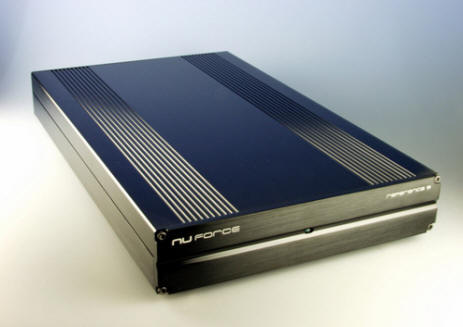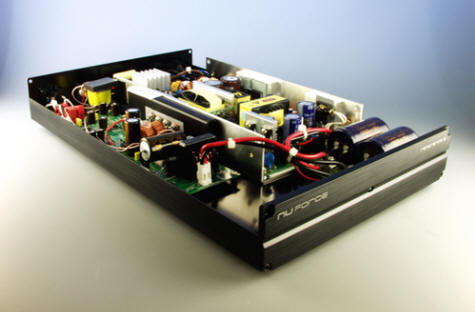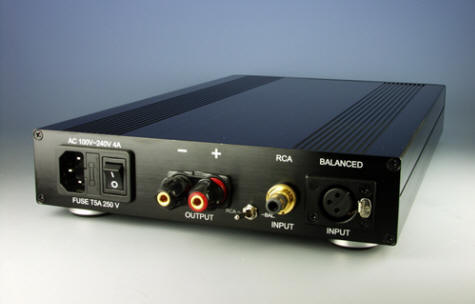You are reading the older HTML site
Positive Feedback
ISSUE
22
nuforce
Reference 9 amplifiers
as reviewed by Robert H. Levi and Ed Morawski

|
ROBERT H. LEVI'S SYSTEM
LOUDSPEAKERS
ELECTRONICS
SOURCES
CABLES
ACCESSORIES
|
 If
I knew the science behind a switching amplifier, I might be able to explain the
flabergasting sound of the NuForce Reference 9 amplifiers. When two
seven-pound, $2400-per-pair monoblocks can drive my inefficient, $22,000 Avalon
Eidolons with elegant ease, and to unlimited volume levels, I am impressed! The
9s are the least expensive amplifiers I've ever tried on the Eidolons, and I am
astonished to say that they come close to the best.
If
I knew the science behind a switching amplifier, I might be able to explain the
flabergasting sound of the NuForce Reference 9 amplifiers. When two
seven-pound, $2400-per-pair monoblocks can drive my inefficient, $22,000 Avalon
Eidolons with elegant ease, and to unlimited volume levels, I am impressed! The
9s are the least expensive amplifiers I've ever tried on the Eidolons, and I am
astonished to say that they come close to the best.
Here's what I know. These are the third and most powerful set of switching amplifiers produced to date by NuForce of Milpitas, California, and the most expensive. NuForce sells the switching module as an OEM supplier. The 9s come with all the necessary connections—balanced and single-ended inputs, a detachable power cord, and very high-quality binding posts for spades and bananas are all on board. There is a large power switch on the rear and a light on the front. I placed them side by side on a Zoethicus amp stand and ran them balanced with the Harmonic Technology CyberLight interconnects and Magic Tweeter speaker cables. The amps were plugged into my World Power Wing, recently outfitted with gold Oyaide AC sockets.
The 9s take twelve hours to reach their best, so don't ever turn them off. They are very, very sensitive to power cords. For a change, the stock cords were not bad, but did not bring these super amps up to their top performance. I tried nearly every power cord I had. I settled on the $400 Eichmann Express cords, but there may be any number of others that will do as well.
The NuForce Amps do not sound like tube amps or solid-state amps or digital amps. They don't sound like hybrids either. I'd describe them as the most intellectually appealing and neutral amps I've yet encountered. They have ultra-low distortion at all power levels. They are powerful, with an available 300 watts RMS into a 4-ohm load, with 650 watts peak power. They have a damping factor of more than 4000! This is not a typo. They have a signal-to-noise ratio of -120dB. They also have a power bandwith out to 50kHZ.
On a scale of 1 to 10, with 10 being state of the art, here's how I would rate the NuForce 9s:
-
Ambience retrieval: 9
-
Depth perspective: 9
-
Smoothness: >9
-
Snap/Sparkle: 8
-
Pacing: 9
-
Soundstaging: 9
-
Imaging: 9
-
Quiet: 9
-
Lack of audible distortion: 9
-
Textural cues: 7-8
-
High-range definition: 8
-
Midrange definition: 8
-
Low-end definition: 9
-
Power and slam: 9
-
Overall definition: >8
-
Neutrality with lack of colorations: 9
Best attributes: trend-setting colorlessness and see-through transparency plus amazing bass
Flaws: the 9s only hint at warmth and sweetness, and textures could be fuller.
The flaws of the 9s are why I call them THE amplifiers for the intellectual. They appeal to the mind more successfully than they appeal to the heart. They filter out the warmth, liquidity, and sweetness of many of my favorite recordings. They made my Marantz 10B and my MD 108 sound almost the same—the textural warmth that separates these top tuners was no longer obvious. The 9s made me wonder: Can the window between the listener and the music be TOO clean?
Push these little guys to full power and you'll not hear a trace of hardness or brittleness, and not so much as a hint of compression or strain. My $16,000 Pass X 600s nearly drove me out of the room at high levels with the Avalons. The 9s intrigue while they pull you into the performance. They perform like $6000+ solid-state amps, and better than most of them. If you like your music powerful, neutral, slippery smooth, and super detailed, the 9s are your ticket. If you're looking for sweetness and love, warmth and liquidity, they're not for you.
With the 9s, there is no direct link between volume and distortion. Almost every solid-state or hybrid amp I've heard gets edgy as you increase the volume. Some won't play above moderate volume without getting hard and glassy. Tube amps become compressed and less elegant. Even powerhouse amps (of all kinds) become congested as they reach their maximum levels. I used to blame this on room/speaker interaction, humidity, etc., but maybe, just maybe, it was the amps misbehaving. The 9s are unflappable, and that's that. I'm not always in the mood for completely neutral sound, but I do love the openness and lack of strain of the 9s. With a damping factor exceeding 4000, the 9s control the speaker drivers like iron fists, keeping them from distorting at higher volumes (or any volume). This would explain their amazing neutrality and lack of graininess. It might also explain their reduced richness and liquidity.
I must comment on the bass. It's nearly perfect. A bit more warmth and textural richness would be nice, but holy cow is it tummy-rattling! The 9s have very "smart" bass—matter-of-fact powerful, deep, detailed, and rocketship fast. It is very cool to hear the first wave, second wave, and back wave of a kettledrum. I didn't turn on my Rel subwoofer once during this evaluation.
The NuForce Reference 9 switching amplifiers are a technological tour de force. They have almost all of the best attributes of the many different types of amplifiers that have come before, and trump many of them. They have groundbreaking neutrality, incredible detail, supreme smoothness, and near state-of-the-art bass, among their many attributes. They will have their strongest appeal among intellectual audiophiles who value definition, accuracy, and smoothness over all other qualities, and there are many. The NuForce 9s have supremely low distortion and ultra-high power, and simply will not become edgy, glassy, or brittle. They will be a boon to those looking to tame those electrostatic or ceramic tweeters without reducing definition and dynamics. If you want to listen to music at the speed of light, the NuForce Reference 9s will take you there in first class, and at the bargain price of the century! Robert H. Levi
Discs used in this evaluation:
-
Miles Davis, Kind of Blue (Columbia SACD 64935)
-
Jacintha, Here's to Ben (Groove Note SACD 1001-3)
-
Cannonball Adderely, Know What I Mean? (Analogue Productions SACD 9433SA)
-
Pink Floyd, The Dark Side of the Moon (Capitol SACD 7243)
-
Diana Krall, Love Scenes (Impulse SACD 2841-36)
-
SuperBass 2 (Telarc SACD 63483)
-
Orff, Carmina Burana (Telarc SACD 60575)
-
Suppe, Overtures (Mercury SACD 470-638-2)
-
Stokowski, Rhapsodies (RCA/BMG SACD 82876)
-
Brahms/Tchaikovsky, Heifetz (RCA/BMG SACD 82876)
-
Gene Harris, The Best of the Concord Years (Concord Records 40932)
|
ED MORAWSKI'S SYSTEM
LOUDSPEAKERS
ELECTRONICS
SOURCES
CABLES
ACCESSORIES
|
 When
PFO editor Dave Clark asked me to review the 160-watt NuForce Reference 9
monoblock amps, my reaction was, "Oh man, I'm really enjoying my AES SixPacs
right now!" I was whining, but Dave's comeback was, "Why don't you do a
comparison?" That sounded like a great idea, but I'll admit that I was extremely
biased against the NuForce amps, for several reasons. When I first heard them, I
thought they sounded terrible. The bass was bloated, the soundstage was
recessed, and the overall presentation was mediocre. Worst of all, they emitted
loud pops through my speakers when I turned them on. That really disturbed me,
since I don't get paid enough as a reviewer to have my equipment wrecked.
When
PFO editor Dave Clark asked me to review the 160-watt NuForce Reference 9
monoblock amps, my reaction was, "Oh man, I'm really enjoying my AES SixPacs
right now!" I was whining, but Dave's comeback was, "Why don't you do a
comparison?" That sounded like a great idea, but I'll admit that I was extremely
biased against the NuForce amps, for several reasons. When I first heard them, I
thought they sounded terrible. The bass was bloated, the soundstage was
recessed, and the overall presentation was mediocre. Worst of all, they emitted
loud pops through my speakers when I turned them on. That really disturbed me,
since I don't get paid enough as a reviewer to have my equipment wrecked.
I did some research, and found that although the NuForce 9s had received some stellar comments on the web, there were also plenty of negative reports, especially with respect to hum, buzz, and noise, not to mention outright failure (see www.6moons.com/audioreviews/NuForce/ref8.html). I reread the owner's manual, but found nothing that suggested I had done anything wrong, so I put the NuForce amps away and continued to listen to my SixPacs. A few days later, I decided to give the Reference 9s one last try before informing Dave of the results. I turned the volume all the way down on my E.A.R. 864 preamp, but the pops were still there when I powered up the amps (although they were a little lower in volume). NuForce just plain has to fix this.
Instead of the cables I had used before, I connected the 9s with Shunyata Research Diamondback power cords and Empirical Audio Interconnects. I also tried a different CD—Tift Merritt's Bramble Rose—and damn, the amps sounded good! In fact, they sounded really, really good. Why did they sound bad before? Had they not been warmed up enough? (They get hot for digital amps.) Had I used the wrong cables? The wrong music? Or was I just in a bad mood that day? Perhaps I didn't give them enough time, as they take a bit of getting used to—I can't explain why, but the sound of the NuForce amps is different. Once I was able to overlook the pops, I could hear some great things about these amps.
The NuForce 9s show absolutely no sign of any digital artifacts. If you didn't know these amps were digitally based, you would never believe it. They are as smooth and musical as any analog amp, and superior to any digital amp I have heard to date. Many have compared them to tube amps, and I have to join that group. I also heard almost no discernible difference between the NuForce 9s and my AES Sixpacs (read that review here). The 9s produce a bit more bass and perhaps a slightly wider soundstage, while the Sixpacs have more detail and air, but it was almost too close to call.
The workmanship of the Reference 9s is quite high. Although you might have heard that they are very light in weight, I found them perfect at 7 pounds each. While they are small enough to fit almost anywhere (8½ x 14 x 2 inches), unlike most digital amps they are heavy enough to stay in place with large speaker cables connected.
NuForce is quick to point out that the Reference series amps are not digital switching class D. While their website proclaims them to be "analog switching," they don't disclose what class they are:
NuForce amplifier technology is based upon the principle that a power oscillator can be modulated by an audio signal so that it produces an amplified audio signal obtained with a reconstruction filter, without the bandwidth limitation of a fixed frequency carrier-based conventional PWM control. It uses a high-performance analog modulation technique and a close-loop control system. Therefore NuForce refers to its audio amplifier as Analog Switching Amplifier…. Unlike some other Class-D amplifiers, NuForce's analog switching amplifier does not require a sawtooth waveform for modulation, but a proprietary naturally occurring modulating signal. In conjunction with taking the signal at the loudspeaker terminals thereby eliminating all distortions, NuForce's natural switching signal does not add noise into the system. NuForce amplifier also does not suffer from the 180-degree phase shift caused by the output filter.
Notice they say "unlike some other class-D amplifiers," so are they or aren't they? A lot is also made of their switching speed of 500,000 Hz and their improved power supplies, but it sounds to me that the amp has a type of switching power supply that is very common in the computer world. Also interesting is the fact that the company proclaims that the amps have no phase shift, which may account for the unique sound.
After many hours of listening to these amps, I can say that bass is their forte. It is prodigious, firm, and very well defined. To test bass, I always play the title track of Keiko Matsui's "Deep Blue." This track can cause extreme havoc if not under strict control by the amplifier(s) and speakers. Using this track, I switched between my Sixpacs, my DK Designs VS-1, and the NuForce units, using my Radio Shack dB meter to carefully set the volume control each time. (The NuForce amps were considerably louder at the same volume setting than the other amps.) The comparisons were interesting. The Sixpacs' bass actually sounded best, but did not go as deep as that of the VS-1 or the Reference 9s. The VS-1 and the NuForce were so close that I had to switch back and forth numerous times to hear a difference. They both went equally low, but the Reference 9s had a slight edge in controlling the bass notes and restricting their bloom.
The Sixpacs had the best midrange, followed by the VS-1 and then the NuForces, by a tiny margin. The Reference 9s really came into their own on the top end, where they put the other two amplifiers to shame with respect to resolution and transparency. Another strong point is their soundstage, which is much wider than that of the Sixpacs, though I suspect that your mileage will vary depending upon your choice of speakers. When I tried my Von Schweikert VR-1s, the soundstage suddenly popped both forward and backward. I did notice that the NuForce amps benefited from extensive warmup. When I left them on overnight before listening, they sounded better by a fairly wide margin. By leaving them on, I also avoided those annoying pops when powering them up.
As is my practice, I took the NuForce 9s out of my system for a week and returned to my reference system, then put the Reference 9s back just before finishing this review. The most apparent change was in the bass. It is quite astonishing how much bass these little amps produce—I never got completely used to it. I was quite pleased with the Reference 9s. Not only do they represent very good value for the money, but they also offer convenience, power, quality, but most importantly, extremely good sound. Ed Morawski
Reference 9 amplifiers
Retail: $1250 per unit
NuForce
web address: http://www.nuforce.com
Ed is currently involved in the manufacturing of Olympic Loudspeakers.


